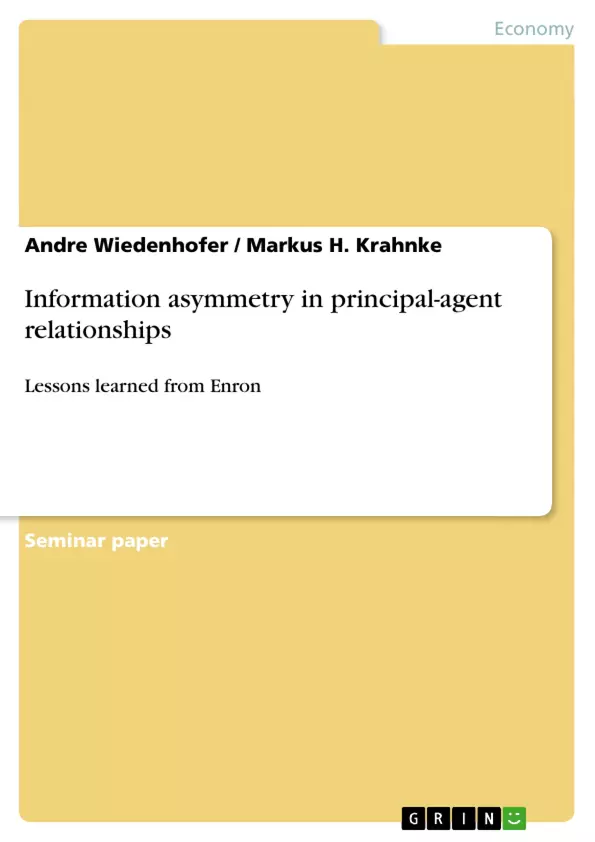This paper investigates the principal-agent problems within the collapse of Enron and why safeguarding activities did not lead to positive results. Having set the framework of principal-agent relationship in general, the focus will be put on Enron. In order to reduce the complexity two specifc cases will be extracted from overall case of Enron. Different potential safeguarding activities will be crafted. Finnally, it will be stated, that separating the implementation of safeguarding activities can be lead to the desired results.
Inhaltsverzeichnis (Table of Contents)
- EXECUTIVE SUMMARY
- TABLE OF CONTENTS
- LIST OF FIGURES
- 1 INTRODUCTION
- 2 SCOPE OF WORK
- 3 PRINCIPAL-AGENT RELATIONSHIPS
- 3.1 Theoretical framework
- 3.2 Characteristics of actors
- 3.3 Agency problems
- 3.3.1 Moral Hazard
- 3.3.1.1 Hidden information
- 3.3.1.2 Hidden actions
- 3.3.2 Hold up
- 3.3.3 Adverse selection
- 3.3.1 Moral Hazard
- 3.4 Methods of Resolution
- 4 MAPPING TO THE ENRON AFFAIR
- 4.1 History of the Enron's situation
- 4.2 Key actors
- 4.2.1 Kenneth Lay
- 4.2.2 Jeffrey Skilling
- 4.2.3 Andrew Fastow
- 4.3 Examplary principal-agent relationships within Enron
- 4.3.1 Case 1: Special Purpose Entities
- 4.3.2 Case 2: 401(k) Savings Plan
- 5 BALANCING THE METHODS OF RESOLUTION WITHIN ENRON
- 5.1 Case 1: Special Purpose Entities
- 5.2 Case 2: 401 (k) Savings Plan
Zielsetzung und Themenschwerpunkte (Objectives and Key Themes)
This paper examines the principal-agent problems that contributed to the collapse of Enron and investigates why safeguarding measures failed to prevent the disaster. The study analyzes specific cases within Enron, demonstrating how agents exploited their power to manipulate safeguarding mechanisms. The work focuses on designing safeguarding activities that would prevent future exploitation within principal-agent relationships.
- Principal-agent relationships in the context of corporate governance
- Information asymmetry and its impact on decision-making
- The role of safeguarding activities in mitigating agency problems
- The effectiveness of different methods of resolution within principal-agent relationships
- Analyzing the Enron case to illustrate the challenges and consequences of information asymmetry
Zusammenfassung der Kapitel (Chapter Summaries)
The paper begins by establishing the theoretical framework for principal-agent relationships, outlining the characteristics of actors and exploring the various agency problems, including moral hazard, hold-up, and adverse selection. It then discusses methods of resolution for these problems. The study moves on to examine the Enron affair, detailing its history, key actors, and specific examples of principal-agent relationships. The analysis focuses on two cases: Special Purpose Entities and the 401(k) Savings Plan, demonstrating how agents manipulated safeguarding activities in these contexts.
Schlüsselwörter (Keywords)
The paper explores key topics such as information asymmetry, principal-agent relationships, agency problems, corporate governance, safeguarding activities, Enron, moral hazard, adverse selection, hold-up, special purpose entities, and employee stock options. It delves into the impact of these factors on the collapse of Enron and analyzes the effectiveness of different methods of resolution in mitigating agency problems.
- Citation du texte
- Andre Wiedenhofer (Auteur), Markus H. Krahnke (Auteur), 2006, Information asymmetry in principal-agent relationships, Munich, GRIN Verlag, https://www.grin.com/document/76339



